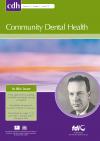Community Dental Health

- Cover Date:
- June 2010
- Print ISSN:
- 0265 539X
- Vol:
- 27
- Issue:
- 2
Caries experience and oral health behaviour among 11 – 13-year-olds: an ecological study of data from 27 European countries, Israel, Canada and USA
Objective: This study is a part of the cross-national survey on health behaviour in school-aged children (HBSC) – World Health Organization Collaborative Study. The aim was to compare the HBSC data on frequency of toothbrushing, consumption of sweets, soft drinks, fruits and vegetables among 11–13-year-old children in different countries and to estimate the relation of these factors with caries experience at the country level. Methods: Oral health behaviour patterns were assessed from the HBSC survey conducted in the 2001-2002 school year in 27 countries in Europe, Israel, Canada, and the USA. Participants: Representative samples of 11- and 13-year-old schoolchildren were drawn from participating countries and aggregated by the direct age standardisation method. DMFT of 12-year-olds was collected from the international data banks and recent publications. Statistical analysis was performed using multiple linear regression. Results: The most significant factor related with the cross-regional variation of DMFT was the proportion of children who reported regular toothbrushing; it explained 26.3% of the DMFT variation. Low rates of regular toothbrushing and high rates of sweets consumption were related with higher DMFT while high rates of drinking of soft drinks were related with lower DMFT. Consumption of fruits and vegetables had no significant impact. Altogether, factors of this model explained 51.2% of the total DMFT variation across countries. Conclusion: The findings of the study demonstrate that different oral health behaviour profiles among young people across European countries, Israel, Canada, and the USA significantly contribute to the variation in caries experience.
Key words: Children, dental caries, diet, DMFT, toothbrushing.
- Article Price
- £15.00
- Institution Article Price
- £
- Page Start
- 102
- Page End
- 108
- Authors
- A. Zaborskis, S. Milciuviene, J. Narbutaite, E. Bendoraitiene, A. Kavaliauskiene
Articles from this issue
- Title
- Pg. Start
- Pg. End
- A health equity methodology for auditing oral health and NHS General Dental Services in Sheffield, England.
- 68
- 73
- Effectiveness of structured comprehensive paediatric oral health education for parents of children less than two years of age in Germany
- 74
- 80
- Reliability analysis of visual examinations carried out by schoolteachers and a dental assistant in the detection of dental caries.
- 89
- 93
- Caries experience and oral health behaviour among 11 – 13-year-olds: an ecological study of data from 27 European countries, Israel, Canada and USA
- 102
- 108
- Development of a measure of childhood information learning experiences related to dental anxiety
- 122
- 128
